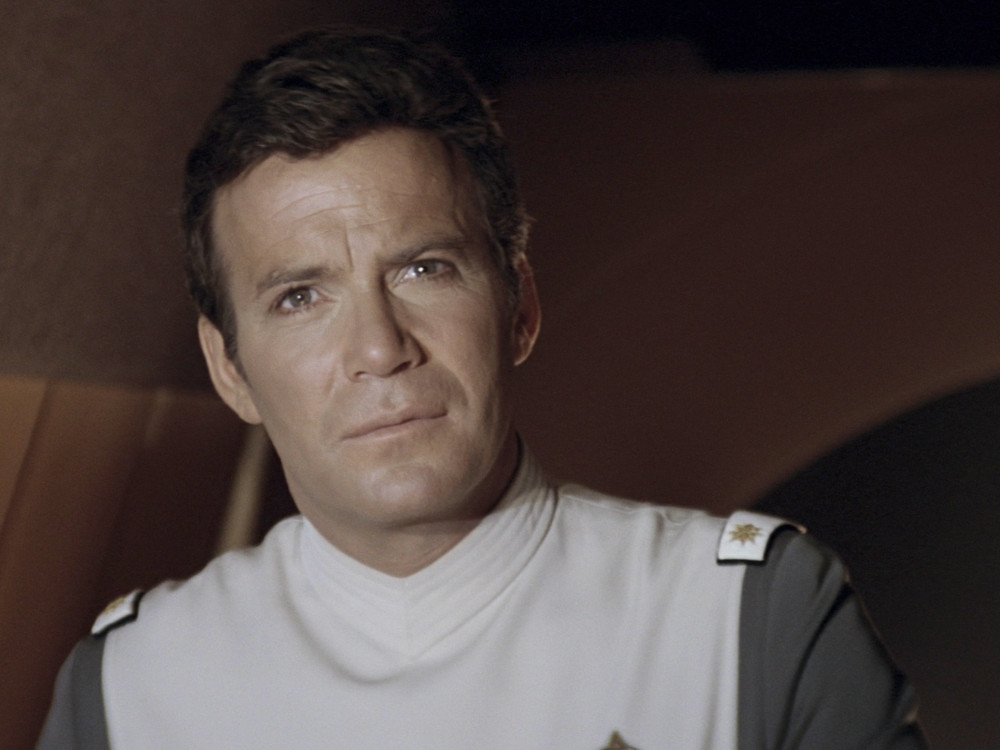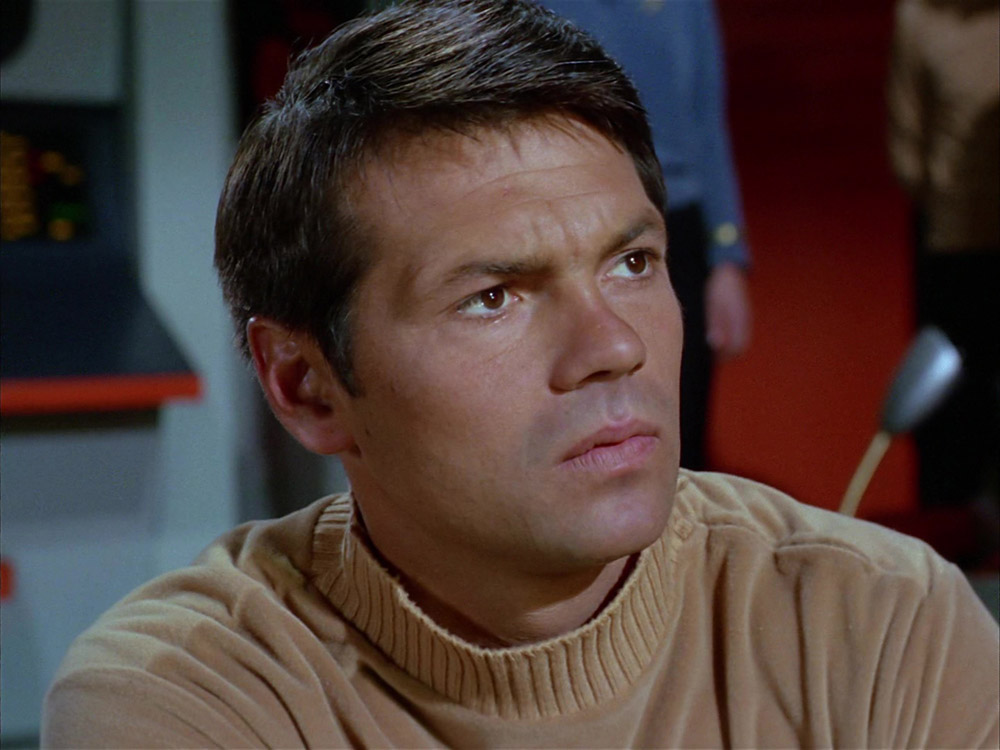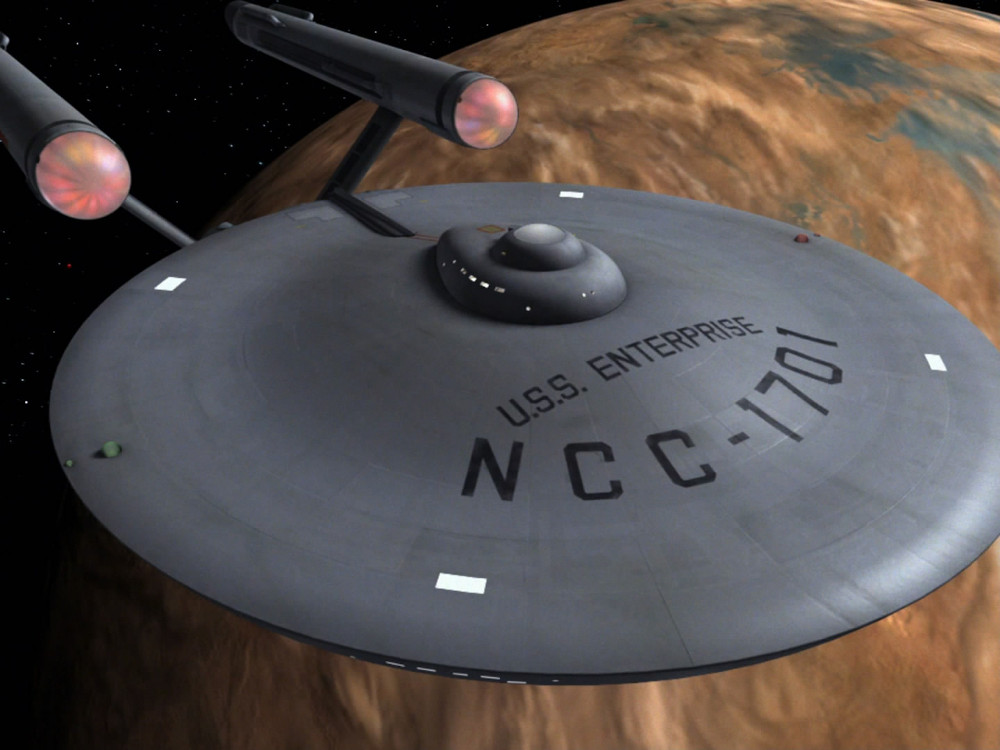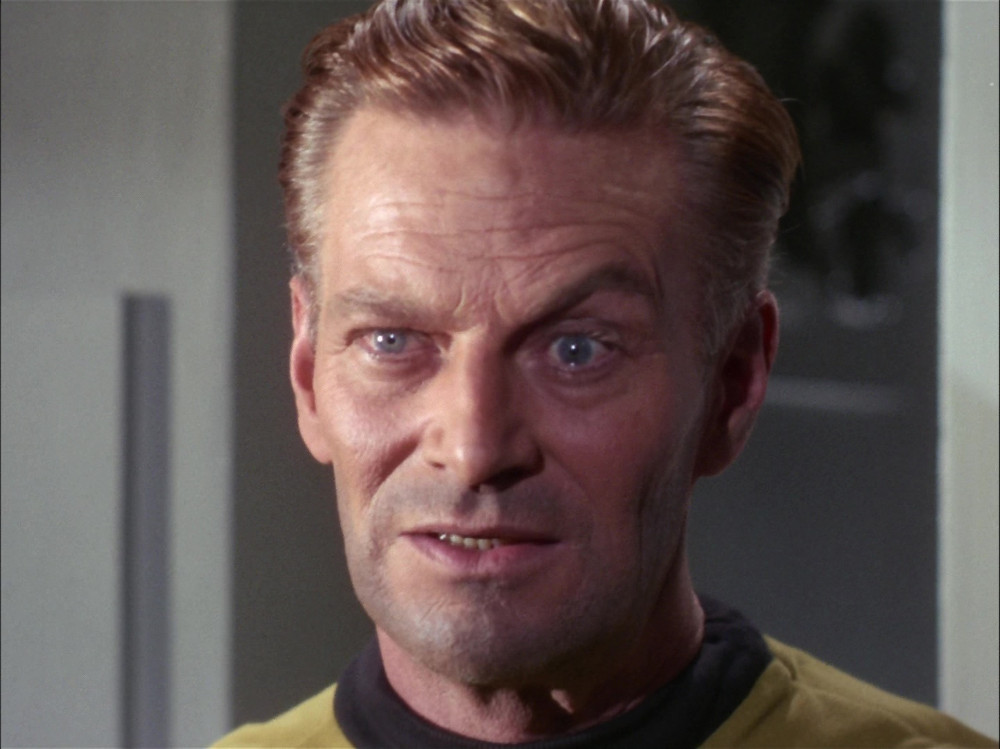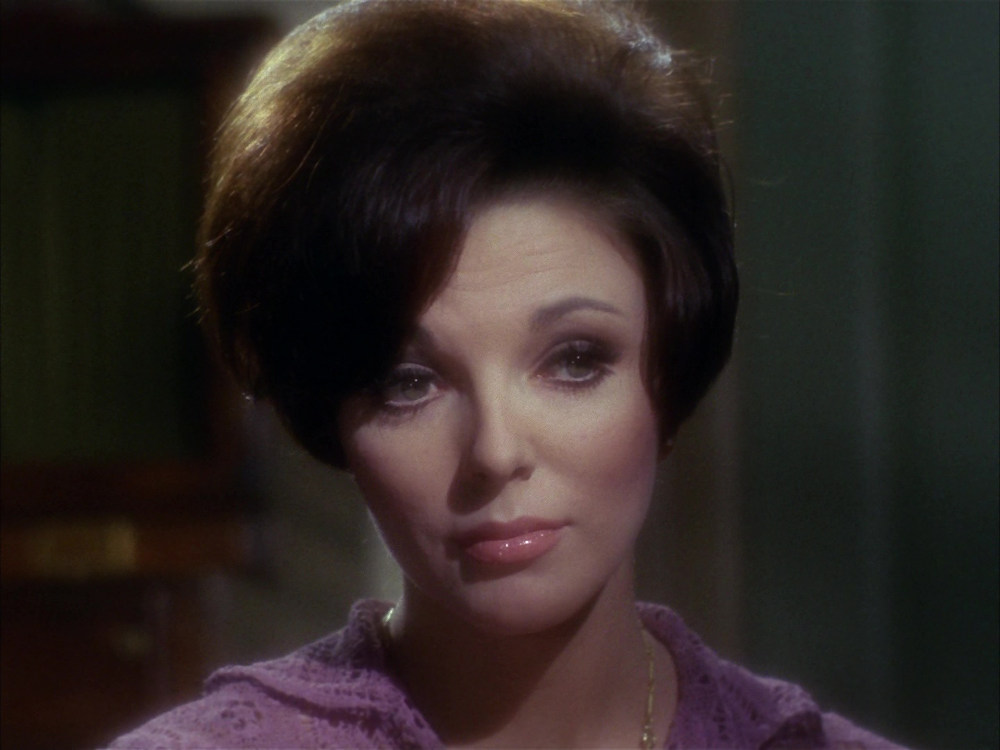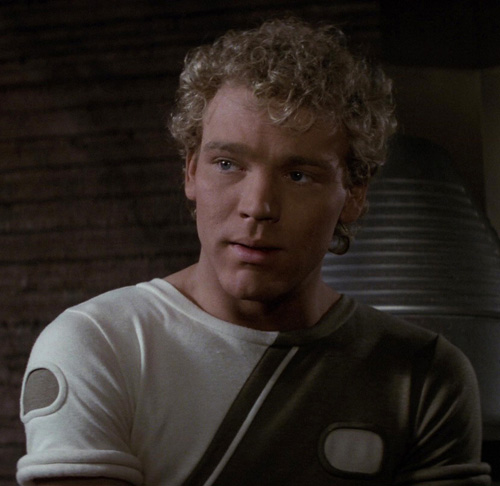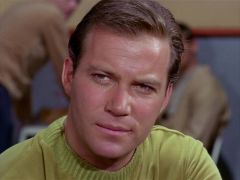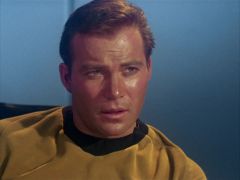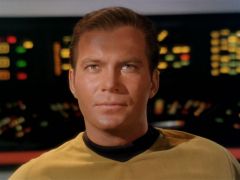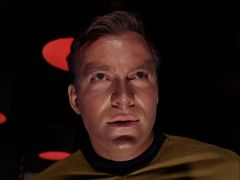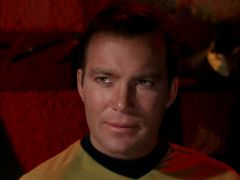James T. Kirk (FASA)
| Species | Human |
| Sex | Male |
| Born | Stardate 1277.1 |
| Family | Eugene Kirk, Father Marjorie Kirk, Mother |
| Serial Number | SC937-0176CEC[1] |
| Portrayed by | William Shatner |
| Advertising |
James Tiberius Kirk was born on Stardate 1277.1,[2] on 28 July 2173[1][3] to Eugene and Marjorie Kirk at Farside Base, Luna.[3] Kirk was raised with his older brother, George Samuel Kirk,[4] and younger sister, Michele Suzanne Kirk,[3] in Iowa,[5] though he also accompanied his parents to other planets, such as Tarsus IV, where he was one of only nine eyewitnesses to survive the massacre of half the colony's population by Governor Kodos in 2189, and he would never forget what he saw.[6] Kirk was a skillful tactician, and was able to beat Spock, a master player himself, at chess, utilizing illogical but successful strategies to win the game.[2]
Kirk learned several languages, and could speak English/Galacta,[2] French, German,[3] and Orion.[1]
Academy Years
| 2190-2193 | Star Fleet Academy, Cadet[3] |
| 2193 | U.S.S. Republic NCC-1373, Cadet Cruise, Assistant Engineering Officer[7] |
| 2194 | U.S.S. Farragut NCC-1647, Lieutenant, Assistant Science Officer[8] |
| 2201-2203 | U.S.S. El Dorado NCC-1724, Lieutenant Commander, First Officer[3] |
| 2203-2207 | U.S.S. Saladin NCC-500, Commander, Commanding Officer[3] |
| 2207-2212 | U.S.S. Enterprise NCC-1701, Captain, Commanding Officer[9][10][11][12][13] |
| 2212-2217 | Star Fleet Command, Admiral, Chief of Operations Command[14] |
| 2217-2222 | U.S.S. Enterprise NCC-1701, Admiral, Commanding Officer[14] |
| 2222 | Star Fleet Academy, Admiral, Commandant[15] |
| 2223 | U.S.S. Excelsior NX-2000, Admiral, Commanding Officer[16] |
| 2224-? | U.S.S. Enterprise NCC-1701-A, Captain, Commanding Officer[5] |
Kirk entered Star Fleet Academy at the age of 17,[17] and was sponsored by Admiral Jay Mallory.[3] He was a brilliant and dedicated cadet, though some people, including an upperclassman named Finnegan, thought he was too serious and bookish.[17] Kirk was particularly impressed by one of his instructors, a history professor named John Gill, whom he considered one of the kindest and gentlest men he had ever met.[18] Kirk proved himself to be more than just an academic when he was the first cadet to beat the Kobayashi Maru scenario, a test designed to confront aspiring starship captains with a no-win situation. Refusing to accept that there was such a thing, Kirk broke into the Academy’s computer and reprogrammed the scenario so that he could achieve all his goals. Far from being criticized for his behavior, he was commended for original thinking.[15]
Assigned to the U.S.S. Republic NCC-1373 for his cadet cruise, Kirk befriended one of his instructors, Lieutenant Ben Finney. The two were close enough that Finney named his daughter Jamie in his honor, but that friendship didn't prevent Kirk from doing his duty. One day, Kirk relieved Finney on watch and discovered that he had left a circuit to the ship’s atomic matter piles open, seriously endangering the ship and the lives of everyone aboard. Kirk closed the circuit and logged the incident. As a result, Finney was reprimanded and moved to the bottom of the promotions list. He failed to accept responsibility for the incident and blamed Kirk, resulting in more than a decade of enmity from the older man.[7] While assigned to the Republic, Kirk was part of a mission to the planet Axanar, where one of his heroes, Captain Kelvar Garth, had won a famous victory. Kirk was awarded the Palm Leaf of Axanar for his part in the Republic's mission.[19]
After his tour on the Republic ended, Kirk returned to the Academy, where he became a student tutor. The class he taught earned quite a reputation among other cadets, who knew that in Kirk’s class it was "think or sink." Kirk became friends with one of his students, Gary Mitchell, whom Kirk would later request on his first command.[2] Kirk left a lasting impression on many of his other contemporaries, including R.M. Merrick, who was expelled after failing a psychosimulator test. Years later, Merrick still remembered Kirk as an example of all that was best about Star Fleet officers.[20] During his time at Star Fleet Academy, Kirk had at least three serious relationships: one with a blonde lab technician,[2] one with Janice Lester, which lasted a year,[21] and one with a beautiful young woman named Ruth.[17] Kirk's relationship with the unnamed lab technician was engineered by Mitchell to distract Kirk, a tough taskmaster whom Mitchell would later describe as "a stack of books with legs," and became so serious that Kirk nealy married her.[2]
Junior Officer
Upon his graduation, Kirk was promoted to Lieutenant, and his first posting was the U.S.S. Farragut NCC-1647 under Captain Garrovick.[8] The young Lieutenant Kirk first experienced command when he led a planetary survey party; during this mission he befriended the leader of the local hill people, a man called Tyree.[22] Kirk was serving aboard the Farragut during the Four Years War, and his experiences would cause him to develop an intense dislike for the Klingons. He was horrified by the way the Klingons maintained "order" on occupied planets, by organizing them into vast labor camps, taking and killing hostages and confining the people's leaders. He became convinced that the Klingons were a brutal people who could not be trusted.[23]
In 2199, Kirk was involved in a serious incident that left him deeply troubled for many years. Near Tycho IV, the Farragut encountered a mysterious and dangerous gaseous entity. Kirk hesitated for a brief moment before firing the ship’s phasers and, when the creature attacked, a third of the crew, including Captain Garrovick, were killed. Although Star Fleet found nothing wrong with his actions, Kirk blamed himself for the disaster.[8]
Starship Command
By 2200, Kirk, now a Lieutenant Commander, met Carol Marcus. Their rekindled relationship ended a year later in 2201,[24] when Kirk was transferred to the U.S.S. El Dorado NCC-1724[25] as first officer, and unbeknownst to Kirk at the time, Marcus was pregnant with their son, David Marcus. When Kirk did finally learn about his son, Marcus asked him not to become involved in their child's upbringing, and Kirk respected her wishes.[15]
Later that year, Kirk became involved with Janet Wallace, an endocrinologist, but their differing career goals pulled them apart.[26] During this period, he was also involved with Areel Shaw, an impressive young lawyer with the Judge Advocate General's office. The two parted on good terms but didn't see one another for several years.[7] In fact, it seems that Kirk’s dedication to his career made it almost impossible for him to form lasting relationships.
Around 2203, Kirk was promoted again and given command of the Saladin class destroyer U.S.S. Saladin NCC-500, a position he held until 2207. He would later remark that "the Farragut was my testing ground as an officer; the El Dorado my testing ground as a diplomat; the Saladin my testing ground as a commanding officer, and the Enterprise my proving ground."[3]
In 2207, Kirk assumed command of the U.S.S. Enterprise NCC-1701, succeeding Captain Christopher Pike[27] and becoming the third commanding officer of that vessel,[28] and beginning what would become an historic Five Year Mission.[2] Kirk had a relaxed command style and enjoyed a close relationship with his crew. Although Kirk and Finney had never reconciled their differences, Kirk did not object when Finney was assigned to his ship as records officer.[7] Kirk also brought along Gary Mitchell, whom he had requested on his first command.[2]
Kirk was on very good personal terms with many of his officers, who respected and admired him. Occasionally, these relationships verged on romance—Kirk evidently became close with Doctor Helen Noel at a science lab Christmas party—but on the whole he felt it was inappropriate to become romantically involved with another member of his crew.[29] Although Kirk didn’t establish any lasting romances, he did form some of the most important friendships of his life while he was aboard the Enterprise. His first officer, the half-Vulcan Spock, and the ship’s Chief Medical Officer, Doctor Leonard McCoy, became his lifelong friends.[15]
Tactically, Kirk was one of the finest officers who ever served in Starfleet, and he consistently proved himself the equal of many adversaries. Kirk’s many exploits included the discovery of replicable means of time travel,[30][31] several important conflicts with the Klingon[23] and Romulan Empires[32] (including a mission where he stole a Romulan cloaking device),[33] the first successful journey across the galactic barrier,[34] and an incident involving the Mirror Universe.[35]
Ben Finney (TOS 14)
Kirk and his crew also repelled several attempts to invade Federation space. In 2210, the Enterprise encountered an automated weapon that had destroyed several planets and crippled the U.S.S. Constellation NCC-1017. Kirk finally managed to defeat the weapon by setting the Constellation to self-destruct and flying it inside the planet-destroying device.[36] In the same year, Kirk and his crew defeated a massive spaceborne "amoeba" cosmozoan that had destroyed the U.S.S. Intrepid NCC-1631 and threatened Federation space.[37] Kirk also convinced the Kelvans to stop their intergalactic invasion plans.[34] Despite all his achievements, in 2208 Kirk stood trial in a court-martial when he was accused of the murder of Ben Finney. During the trial, it emerged that Finney, who was still obsessed with Kirk, had faked his own death, and Kirk was exonerated.[7]
Kirk endured other hard times during his command. On Stardate 1313.8, he was forced to kill Gary Mitchell when his friend gained extremely potent psionic powers after passing through the Galactic Barrier, becoming a serious danger to the rest of the crew and the Federation at large.[2] In 2208, the Enterprise visited Deneva, where Kirk’s older brother, George Samuel Kirk Jr., was working as a research biologist. When the planet was attacked by a race of neural parasites, Sam (as Kirk called him) and his wife Aurelan were killed, and their son Peter barely survived.[38] Fortunately, Sam’s two other sons[4] were not on the planet at the time.[38]
Edith Keeler (1930) (TOS 28)
Kirk also had a difficult time romantically. In 2208, he traveled back in time to 1930 and fell in love with Edith Keeler, but was forced to let her die in order to preserve history.[39] In 2209, Kirk spent several months living among a Native American community when he was stranded on a planetoid with amnesia and went by the name "Kirok." During this time he married a woman named Miramanee, who became pregnant. Shortly after the Enterprise returned to rescue Kirk, she and her unborn child were stoned to death by an angry mob.[40] Later that year, Kirk fell deeply in love with the android Rayna Kapec. He awakened similar feelings in her, but she was unable to cope when asked to choose between Kirk and her creator, the immortal Mr. Flint; her programming failed, and she died. Kirk was so distressed by her death that Spock took the unprecedented step of mind-melding with him to remove the painful memories.[41]
If Kirk had a weakness, it was his obsessive devotion to duty. He was extremely hard on himself and felt personally responsible whenever one of the people under his command was killed. He rarely took shore leave,[17] and Dr. McCoy was forced to order him to relax on more than one occasion. He was extremely devoted to his ship, which he looked on as "a lady" who needed his love.[42] Kirk was just as dedicated to the members of his crew, and he disobeyed direct orders on several occasions in order to help officers under his command. For example, in 2207, he refused to obey Galactic High Commissioner Ferris' order to abandon the search for a shuttlecraft which had been lost while investigating the Murasaki 312 quasar-like phenomenon.[43] The following year, Kirk disobeyed direct orders from Starfleet Command to attend the inaguration of the president of Altair VI. Instead, he ordered the Enterprise to Vulcan because his science officer, Spock, needed to return there in order to deal with his pon farr. Spock held his captain in such high regard that he asked him to be present at the koon-ut-kal-if-fee ceremony. As a result, Kirk and McCoy (who was also present) became part of a select group of Humans who have had first-hand experience of this aspect of Vulcan culture.[44] In general, Kirk was intolerant of bureaucracy and often described himself as a soldier rather than a diplomat. However, he played an important part in resolving several conflicts, including the conflict between Vedikar and Eminiar VII.[45] He also forced the inhabitants of Ardana to reconsider the divisive social system that forced one group of people to work in the zenite mines while others lived in luxury in the floating city of Stratos.[46]
Fortunately for Kirk, he managed to lay some of his demons to rest during his time aboard the Enterprise. In 2208, his friend Thomas Leighton, another survivor from Tarsus IV, told him that he believed he had found Kodos, who had assumed the identity of Anton Karidian, a Shakespearean actor. Leighton was murdered shortly after he revealed his suspicions to his friend, but Kirk’s investigations proved that he had been right about Kodos. The fugitive governor died in an accident when his daughter, Lenore, attempted to kill Kirk.[6] Kirk also again encountered the cloud creature that had attacked the Farragut years earlier. The events that followed proved that Kirk’s hesitation in firing on the creature during its attack on the Farragut had made no difference. Kirk eventually managed to destroy the creature with an antimatter bomb.[8]
When the Enterprise's five-year mission ended in 2212, Kirk was promoted to admiral.[14] He accepted the promotion against the advice of Dr. McCoy, who warned him that he would never be happy unless he was in command of a starship.[15] Kirk recommended that the young Will Decker replace him as captain of the Enterprise, which had just begun a major refit shortly after its return to Earth.[14]
Admiralty
As an admiral, Kirk became Chief of Star Fleet Operations. McCoy's prediction about Kirk's happiness proved right; everyone could see that the admiral was frustrated and unhappy with his desk job. When the Federation was threatened by V'Ger in 2217, Kirk grabbed the opportunity to return to the field. In his obsession to regain command of a starship and save the Federation, Kirk was less than sensitive to the needs of the people around him: in order to resume command of the newly refitted Enterprise, Kirk demoted Decker and assumed personal control of the mission. He also forcibly reactivated Dr. McCoy's commission. Although Kirk's actions may suggest that he was insensitive and egotistical, he was proved right. Under his command, the crew of the Enterprise persuaded V'Ger to abandon its attack on Earth. Decker and the ship’s navigator, Ilia, were lost in the mission.[14]
After the V'Ger threat had passed, Kirk remained in command of the Enterprise and began a new five-year mission of deep space exploration. This mission ended in 2222. Kirk then took up a post as the Commandant of Star Fleet Academy, moving into an apartment in San Francisco so that he could be near his work. By this time, his closest friend, Spock, who had been promoted to captain, was also working as an instructor at the Academy and as Captain of the Enterprise, which was now a cadet training vessel.[15]
By 2223, Kirk was beginning to feel his age. He did not feel that he was young enough to return to the bridge of a starship and, despite Dr. McCoy's advice, he refused to request a command of his own, telling his friend that "galloping around the cosmos is a game for the young." Kirk took the Enterprise on a cadet training mission. At the same time, the genetically engineered Human, Khan Noonien Singh, took control of the U.S.S. Reliant NCC-1864, determined to wreak revenge on Kirk, who had left him on Ceti Alpha V in 2208. The Reliant had been assigned to the Genesis Project, led by Dr. Carol Marcus and Dr. David Marcus, the son she had with Kirk. Khan learned about the project and used it to lure Kirk into a battle near Regula 1, where the Marcuses were based. Although Khan inflicted serious damage on the Enterprise, Kirk's greater experience triumphed and he outfought the Reliant in a tense battle in the Mutara Nebula. At the end of the battle, the Genesis Device was activated, creating a new planet. The mission had a great personal cost for Kirk: Spock was killed by radiation exposure when he repaired the Enterprise's warp engines. The Vulcan was given a burial in space, with Kirk providing the eulogy. Spock’s body came to rest on the newly-formed Genesis Planet.[15]
When the Enterprise returned to Spacedock, Admiral Morrow informed Kirk that the decision had been made to retire the badly damaged ship. Still grieving for his friend, Kirk found it extremely difficult to accept that his ship and crew could be treated in such a way. The same day, Spock’s father, Ambassador Sarek, visited Kirk and asked him to recover Spock’s body from the Genesis Planet and return it to Vulcan. Although Kirk and Spock were extremely close, the Vulcan had not told his friend many details about life on Vulcan. Sarek explained that before they die, Vulcans mind meld with one of their most trusted companions and entrust them with their katra, or soul, which is then taken back to Vulcan with their body. Kirk learned that although Spock had been unable to mind meld with him, he did manage to place his katra in Dr. McCoy’s mind. Demonstrating typical loyalty to his crew, Kirk asked Morrow for permission to return to the Genesis Planet to retrieve Spock’s body, but the admiral refused. Genesis had become the focus of a diplomatic furor, and Starfleet Command had placed the planet off-limits to everyone except essential personnel. Effectively, this meant that the only people allowed to visit the planet were the crew of the U.S.S. Grissom NCC-623, which included David Marcus. This prompted Kirk to make a momentous decision: he disobeyed orders and, with the aid of the Enterprise's senior staff, stole his old ship and went to Genesis. When the Enterprise arrived, the crew discovered that the Grissom had been destroyed by a group of Klingons, and that only Lieutenant Saavik and Dr. Marcus had been left alive on the planet's surface. The damaged and undermanned Enterprise was no match for the Klingon ship, and Kirk was powerless when David was killed by the Klingons. Once again Kirk was faced with apparently insurmountable odds. In a desperate move, he tricked most of the Klingons into boarding the Enterprise, which he destroyed, killing them. Kirk and his staff narrowly escaped the destruction of the Genesis Planet after it became unstable; they managed to retrieve Spock’s body, which had been rejuvenated by the Genesis effect, and took control of the nearly-deserted Klingon Bird of Prey. They then took Spock to Vulcan, where his katra and body were reunited.[47]
Kirk returned to Earth to face the consequences of his actions. However, before he could arrive, Earth was "attacked" by a mysterious probe. Kirk saved Earth by traveling back in time and retrieving two humpback whales from the 20th century. When he returned, nearly all charges were dropped, and he was reduced in rank for disobeying orders. A captain once again, he was placed in command of the U.S.S. Enterprise NCC-1701-A. Kirk was delighted to be back on the bridge of a starship and gratefully accepted the position.[5]
Notes and References
- ↑ 1.0 1.1 1.2 McLimore, Guy W. Jr. et al (Authors). Basic Rulebook. Star Trek: The Role Playing Game. Book 2001A. Box Art and Original artwork by Mitch O'Connell. Ship Deck Plans by Dana Andrews, Ross Babcock, Mitch O'Connell, and Jordan Weisman. FASA Corporation. 1983.
- ↑ 2.0 2.1 2.2 2.3 2.4 2.5 2.6 2.7 2.8 Roddenberry, Gene (Executive Producer). "The Cage". Star Trek, season 0, episode 0 (Production number 01). Directed by Robert Butler. Written by Gene Roddenberry. Released 1986. Desilu Productions. 1965.
- ↑ 3.0 3.1 3.2 3.3 3.4 3.5 3.6 3.7 3.8 Rotsler, William (Author). Star Trek II Biographies. Star Trek. Novel. Wanderer Books. December 1982.
- ↑ 4.0 4.1 Roddenberry, Gene (Executive Producer). "Balance of Terror". Star Trek, season 1, episode 14 (Production number 09). Directed by Vincent McEveety. Written by Paul Schneider. Desilu Productions. 15 December 1966.
- ↑ 5.0 5.1 5.2 Bannett, Harve (Producer). Star Trek IV: The Voyage Home. Directed by Leonard Nimoy. Story by Leonard Nimoy and Harve Bennett. Screenplay by Steve Meerson & Peter Krikes and Harve Bennett & Nicholas Meyer. Paramount Pictures. 26 November 1986.
- ↑ 6.0 6.1 Roddenberry, Gene (Executive Producer). "Miri." Star Trek, Season 1, Episode 8 (Production 12). Directed by Vincent McEveety. Written by Adrian Spies. Desilu Productions, 27 October 1966.
- ↑ 7.0 7.1 7.2 7.3 7.4 Roddenberry, Gene (Executive Producer). "The Galileo Seven." Star Trek, Season 1, Episode 16 (Production 14). Directed by Robert Gist. Story by Oliver Crawford Teleplay by Oliver Crawford & S. Bar-David. Desilu Productions, 5 January 1967.
- ↑ 8.0 8.1 8.2 8.3 Roddenberry, Gene (Executive Producer). "Obsession." Star Trek, Season 2, Episode 18. Directed by Ralph Senensky. Written by Art Wallace. Desilu Productions, 15 December 1967.
- ↑ Roddenberry, Gene (Executive Producer). Star Trek, season 1. Desilu Productions. 1966-1967.
- ↑ Roddenberry, Gene (Executive Producer). Star Trek, season 2. Desilu Productions. 1967-1968.
- ↑ Roddenberrry, Gene (Executive Producer). Star Trek, season 3. Producer: Fred Freiberger. Paramount Pictures. 1968-1969.
- ↑ Scheimer, Lou & Norm Prescott (Producers). Star Trek: The Animated Series, season 1. Filmation Associates. 1973-1974.
- ↑ Scheimer, Lou & Norm Prescott (Producers). Star Trek: The Animated Series, season 2. Filmation Associates. 1974-1974.
- ↑ 14.0 14.1 14.2 14.3 14.4 Roddenberry, Gene (Producer). Star Trek: The Motion Picture. Directed by Robert Wise. Story by Alan Dean Foster. Screenplay by Harold Livingston. Paramount Pictures. 7 December 1979.
- ↑ 15.0 15.1 15.2 15.3 15.4 15.5 15.6 Salin, Robert (Producer). Star Trek II: The Wrath of Khan. Directed by Nicholas Meyer. Story by Harve Bennett and Jack B. Sowards. Screenplay by Nicholas Meyer (Uncredited). Paramount Pictures. 4 June 1982.
- ↑ Barr, Mike W. (Writer). "New Frontiers, Chapter 8: Homecoming..." Star Trek, volume 1, issue 16. Art by Tom Sutton & Ricardo Villagran. Colors by Michele Wolfman. Lettering by John Costanza. Edited by Marv Wolfman. DC Comics, July 1985.
- ↑ 17.0 17.1 17.2 17.3 Roddenberry, Gene (Executive Producer). "Shore Leave." Star Trek, Season 1, Episode 15 (Production 17). Directed by Robert Sparr. Written by Theodore Sturgeon. Desilu Productions, 29 December 1966.
- ↑ Roddenberry, Gene (Executive Producer). "Patterns of Force." Star Trek, Season 2, Episode 23. Directed by Vincent McEveety. Written by John Meredyth Lucas. Desilu Productions, 16 February 1968.
- ↑ Roddenberry, Gene (Executive Producer) and Freiberger, Fred (Producer). "Whom Gods Destroy." Star Trek, Season 3, Episode 16. Directed by Herb Wallerstein. Story by Jerry Sohl & Lee Erwin. Teleplay by Lee Erwin. Paramount Pictures Corporation, 3 January 1969.
- ↑ Roddenberry, Gene (Executive Producer). "Bread and Circuses." Star Trek, Season 2, Episode 14. Directed by Ralph Senensky. Written by Gene Roddenberry and Gene L. Coon. Desilu Productions, 15 March 1968.
- ↑ Roddenberry, Gene (Executive Producer/Story) and Freiberger, Fred (Producer). "Turnabout Intruder." Star Trek, Season 3, Episode 24. Directed by Herb Wallerstein. Teleplay by Arthur Singer. Paramount Pictures Corporation, 3 June 1969.
- ↑ Roddenberry, Gene (Executive Producer/Teleplay). "A Private Little War." Star Trek, Season 2, Episode 16. Directed by Marc Daniels. Story by Jud Crucis. Desilu Productions, 2 February 1968.
- ↑ 23.0 23.1 Roddenberry, Gene (Executive Producer). "Errand of Mercy." Star Trek, Season 1, Episode 26 (Production 27). Directed by John Newland. Written by Gene L. Coon. Desilu Productions, 23 March 1967.
- ↑ Though no dates were provided for Kirk's relationship with Carol Marcus, David's age in 2223 puts his birth circa 2201.
- ↑ Although Star Trek II Biographies stated that Kirk served as the first officer of the U.S.S. El Dorado NCC-1722, other sources stated that the vessel had been decommissioned and destroyed several years earlier. A new El Dorado was commissioned at about the same time as Kirk's assignment, however, and the reference has been updated to correct the discrepancy.
- ↑ Roddenberry, Gene (Executive Producer). "The Deadly Years." Star Trek, Season 2, Episode 11. Directed by Joseph Pevney. Written by David P. Harmon. Desilu Productions, 8 December 1967.
- ↑ Roddenberry, Gene (Executive Producer). "Court Martial." Star Trek, Season 1, Episode 20 (Production 15). Directed by Marc Daniels. Story by Don M. Mankiewicz. Teleplay by Don M. Mankiewicz and Steven W. Carabatsos (Teleplay). Desilu Productions, 2 February 1967.
- ↑ Scheimer, Lou & Norm Prescott (Producers). "How Sharper Than a Serpent's Tooth". Star Trek: The Animated Series, season 2, episode 5 (Production number 21). Directed by Bill Reed. Written by Russell Bates & David Wise. Filmation Associates. 5 October 1974.
- ↑ Roddenberry, Gene (Executive Producer). "What Are Little Girls Made Of?". Star Trek, season 1, episode 7 (Production number 10). Directed by James Goldstone. Written by Robert Bloch. Desilu Productions. 20 October 1966.
- ↑ Roddenberry, Gene (Executive Producer). "The Man Trap". Star Trek, season 1, episode 1 (Production number 06). Directed by Marc Daniels. Written by George Clayton Johnson. Desilu Productions. 8 September 1966.
- ↑ Roddenberry, Gene (Executive Producer). "Tomorrow is Yesterday." Star Trek, Season 1, Episode 19 (Production 21). Directed by Michael O'Herlihy. Written by D.C. Fontana. Desilu Productions, 26 January 1967.
- ↑ Roddenberry, Gene (Executive Producer). "Charlie X". Star Trek, season 1, episode 2 (Production number 08). Directed by Lawrence Dobkin. Story by Gene Roddenberry. Teleplay by D.C. Fontana. Desilu Productions. 15 September 1966.
- ↑ Roddenberry, Gene (Executive Producer) and Freiberger, Fred (Producer). "The Enterprise Incident." Star Trek, Season 3, Episode 4. Directed by John Meredyth Lucas. Written by D.C. Fontana. Paramount Pictures Corporation, 27 September 1968.
- ↑ 34.0 34.1 Roddenberry, Gene (Executive Producer). "By Any Other Name." Star Trek, Season 2, Episode 21. Directed by Marc Daniels. Story by Jerome Bixby Teleplay by Jerome Bixby & D.C. Fontana. Desilu Productions, 23 February 1968.
- ↑ Roddenberry, Gene (Executive Producer). "Mirror, Mirror." Star Trek, Season 2, Episode 10. Directed by Marc Daniels. Written by Jerome Bixby. Desilu Productions, 6 October 1967.
- ↑ Roddenberry, Gene (Executive Producer). "The Doomsday Machine." Star Trek, Season 2, Episode 6. Directed by Marc Daniels. Written by Norman Spinrad. Desilu Productions, 20 October 1967.
- ↑ Roddenberry, Gene (Executive Producer). "The Immunity Syndrome." Star Trek, Season 2, Episode 19. Directed by Joseph Pevney. Written by Robert Sabaroff. Desilu Productions, 19 January 1968.
- ↑ 38.0 38.1 Roddenberry, Gene (Executive Producer). "Operation -- Annihilate!." Star Trek, Season 1, Episode 29 (Production 29). Directed by Herschel Daugherty. Written by Steven W. Carabatsos. Desilu Productions, 13 April 1967.
- ↑ Roddenberry, Gene (Executive Producer). "The City on the Edge of Forever." Star Trek, Season 1, Episode 28 (Production 28). Directed by Joseph Pevney. Written by Harlan Ellison. Desilu Productions, 6 April 1967.
- ↑ Roddenberry, Gene (Executive Producer) and Freiberger, Fred (Producer). "The Paradise Syndrome." Star Trek, Season 3, Episode 3. Directed by Jud Taylor. Written by Margaret Armen. Paramount Pictures Corporation, 4 October 1968.
- ↑ Roddenberry, Gene (Executive Producer) and Freiberger, Fred (Producer). "Requiem for Methuselah." Star Trek, Season 3, Episode 21. Directed by Murray Golden. Written by Jerome Bixby. Paramount Pictures Corporation, 14 February 1969.
- ↑ Roddenberry, Gene (Executive Producer). "This Side of Paradise." Star Trek, Season 1, Episode 24 (Production 25). Directed by Ralph Senensky. Story by Nathan Butler. Teleplay by Nathan Butler & D.C. Fontana. Desilu Productions, 2 March 1967.
- ↑ Roddenberry, Gene (Executive Producer). "The Conscience of the King." Star Trek, Season 1, Episode 13 (Production 13). Directed by Gerd Oswald. Written by Barry Trivers. Desilu Productions, 8 December 1966.
- ↑ Roddenberry, Gene (Executive Producer). "Amok Time." Star Trek, Season 2, Episode 5. Directed by Joseph Pevney. Written by Theodore Sturgeon. Desilu Productions, 15 September 1967.
- ↑ Roddenberry, Gene (Executive Producer). "A Taste of Armageddon." Star Trek, Season 1, Episode 23 (Production 23). Directed by Joseph Pevney. Written by Robert Hamner (Story and Teleplay) and Gene L. Coon (Teleplay). Desilu Productions, 23 February 1967.
- ↑ Roddenberry, Gene (Executive Producer) and Freiberger, Fred (Producer). "The Cloud Minders." Star Trek, Season 3, Episode 19. Directed by Jud Taylor. Story by David Gerrold and Oliver Crawford. Teleplay by Margaret Armen. Paramount Pictures Corporation, 28 February 1969.
- ↑ Bennett, Harve (Producer). Star Trek III: The Search for Spock. Directed by Leonard Nimoy. Written by Harve Bennett. Paramount Pictures. 1 June 1984.
